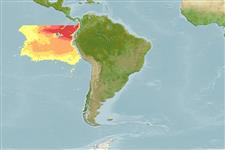Пластиножаберные (акулы и скаты) (sharks and rays) >
Carcharhiniformes (Ground sharks) >
Pentanchidae (Deepwater catsharks)
Etymology: Bythaelurus: bythos (Gr.), depths of the sea, referring to its deepwater habitat; ailouros (Gr.), cat, probably an allusion to the vernacular “catshark,” so named for its cat-like eyes (See ETYFish); giddingsi: In honor of Al Giddings (b. 1937), American underwater filmmaker, naturalist, and friend (See ETYFish).
Eponymy: Al Giddings is an underwater filmmaker and naturalist. He has also been active in the commercial film business as the cameraman for: The Deep (1977) and as co-producer of: Titanic (1997). Moreover, he is a friend of the senior author. (Ref. 128868), visit book page.
More on authors: McCosker, Long & Baldwin.
Environment: milieu / climate zone / depth range / distribution range
экология
морской батипелагический; пределы глубины 428 - 562 m (Ref. 89625). Tropical
Pacific Ocean: presumed to be endemic to the Galápagos Islands.
Size / Вес / Возраст
Maturity: Lm ? range ? - ? cm
Max length : 45.3 cm TL самец/пол неопределен; (Ref. 89625)
Краткое описание
определительные ключи | морфология | морфометрия
This species is moderately sized and have the following characters: snout bluntly rounded;
preoral length 4.7-6.8% TL; short head, length about equal to pectoral-pelvic space, 21-24% TL; precaudal length 73-80% TL; dorsal and anal fins are subequal; length of anal-fin base about equal to length of interdorsal space; 81-85 (mean = 82.6) precaudal vertebrae; color chocolate brown dorsally, paler on ventral surface from snout to anus; body, flanks, caudal and median fins are overlain with pale spots about equal in size to eye, becoming smaller below lateral midline, and showing a bilaterally asymmetrical pattern. It differs from its congeners in its coloration, the length of its anal-fin base, and in other morphological characters (Ref. 89625).
This species were observed living on the bottom above sand or sand and mud substrates,
in the vicinity of lava boulders, either over flat bottoms or along slopes to 45° (Ref. 89625).
Life cycle and mating behavior
половая зрелость | размножение | нерест | икра | Fecundity | личинки
McCosker, J.E., D.J. Long and C.C. Baldwin, 2012. Description of a new species of deepwater catshark, Bythaelurus giddingsi sp. nov., from the Galápagos Islands (Chondrichthyes: Carcharhiniformes: Scyliorhinidae). Zootaxa 3221:48-59. (Ref. 89625)
Статус Красного Списка МСОП (Ref. 130435: Version 2024-2)
Угроза для людей
Harmless
Использование человеком
дополнительная информация
инструменты
Специальные отчеты
Скачать в формате XML
ресурсы в Интернет
Estimates based on models
Preferred temperature (Ref.
123201): 2.6 - 3.3, mean 3.1 °C (based on 9 cells).
Phylogenetic diversity index (Ref.
82804): PD
50 = 0.5001 [Uniqueness, from 0.5 = low to 2.0 = high].
Bayesian length-weight: a=0.00355 (0.00175 - 0.00721), b=3.08 (2.90 - 3.26), in cm total length, based on LWR estimates for this (Sub)family-body shape (Ref.
93245).
Trophic level (Ref.
69278): 4.3 ±0.5 se; based on size and trophs of closest relatives
Fishing Vulnerability (Ref.
59153): Moderate vulnerability (35 of 100).
